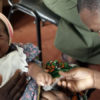NAIROBI,Kenya, Oct 27 – The country has made strides in efforts to eliminate malaria by the year 2030 with a survey conducted by the Division of National Malaria Program showing a decline of malaria cases in children aged 6 months to 14 years by 2 per cent since 2015.
The 2020 Kenya Malaria Indicator Survey (KMIS) survey released by the Division of National Malaria Program reported the prevalence of the disease among the targeted group at 6 per cent compared to 8 per cent in 2015.
Speaking during the launch of the survey’s results, Dr. Mercy Mwangangi, the Chief Administrative Secretary in the Ministry of Health, attributed the progress to sustained interventions by the ministry and its partners.
“This 2 per cent drop in national malaria prevalence can be credited to the continued surveillance and epidemic preparedness efforts mounted by the team at the national malaria program, the county malaria teams and other partners working collaboratively with the ministry,” said Dr. Mwangangi.
The survey reported a significantly higher burden of the disease — 19 per cent — in the Lake region endemic zones which include Siaya, Kisumu, Migori, Homa Bay, Kakamega, Vihiga, Bungoma,and Busia with low risk areas having only 1 per cent.
Among children aged 6 months to 14 years, the survey found a higher malaria prevalence among rural children (7 per cent) than urban children (3 per cent).
Eligible children aged 6 months to 14 years were also tested for anemia. Overall, 2 per cent of children were reported to have low haemoglobin marking an increase from 1 per cent in 2015.
“By malaria endemicity, the prevalence of low haemoglobin levels in children age 6 months to age 14 ranges from less than 1 per cent in the Low risk zone to 3 per cent in the Lake endemic and Seasonal zones,” the report indicated.
Although anemia is not specific to malaria, trends in anemia prevalence can reflect malaria morbidity, and they respond to changes in the coverage of malaria interventions.
Malaria parasitaemia causes more destruction of red blood cells hence reducing haemoglobin levels leading to anemia.
Studies indicated malaria positive children were two fold more likely to be anemic compared with their negative counterparts.
The indicator survey, the fourth to be published since the assessment framework was established, also cited factors such as increase in wealth and age as contributors to the prevalence the epidemic in the country.
“Malaria prevalence according to microscopy generally increases with age, from 3 per cent among children age 6-59 months to 8 per cent among those age 10-14. The prevalence of malaria according to microscopy generally decreases with increasing wealth, from 8 per cent in the second wealth quintile to 2 per cent in the highest quintile,” read the survey report.
The report also captured research on prevention of Malaria among pregnant women with the findings showing an increase in the uptake of 3 or more doses of intermittent preventive treatment in targeted endemic areas.
In the Lake endemic zone, uptake increased to 49 per cent, a 14 per cent increase from 2015, and 49 per cent in the Coast endemic zone, a 3 per cent rise from 2015.
“As Kenya aims to have at least 80 per cent of all pregnant women living in endemic zones receiving at least three doses of IPTp and sustain adherence to policy guidance in non-endemic areas, efforts towards realizing this target must be strengthened and sustained,” said Mwangangi.
Key interventions such the ownership and use of insecticide-treated net (ITN) have seen a downward trend from the previous survey conducted in 2015 (2015 KMIS).
“For example, the percentage of households owning at least one ITN decreased to 49 per cent from 63 per cent in 2015. Similarly, the percentage of the household population who slept under an ITN the night before the survey decreased to 35 per cent from 48 per cent in 2015,” Mwangangi noted.
Dr. George Githuka, the Head of Division of National Malaria Program noted that the stalled progress in some of the malaria prevention interventions have necessitated the need for intensified awareness and behavior campaigns.
The Division of National Malaria Program noted that the coronavirus pandemic had affected the implementation of some of the intervention measures which include seeking medication.
“Due to COVID-19 pandemic, we haven’t been able to distribute insecticide-treated bednets, due to the restriction measures. Also the pandemic is associated with fever so some individuals refused to seek medication in health facilities fearing that it could be corona virus or they would contact the virus in health facilities,” Dr. Githuka said.
“Even with the COVID-19 pandemic, we have ensured we continue with the distribution of insecticide-treated bednets, the availability of medicines at our health facilities and, indoor residual spraying whilst following COVID-19 protocols,” he said.
The 2020 KMIS is the fourth to be conducted in Kenya after 2015 KMIS, 2010 and 2007. Carried out from 9 November to December 2020, the survey was conducted among a nationally representative sample of 6,771 women from 7,952 households aged between 15 and 49 years yielding a response rate of 97 per cent and 96 per cent for target households and women respectively.
Malaria is one of the world’s most deadly disease. In Kenya, the disease is the main cause of death among children under the age of five.
On October 31,2020, President Kenyatta launched the “Zero Malaria Starts with Me” campaign to catalyze implementation of his four-point anti-malaria agenda to eliminate the disease by 2023.





















































